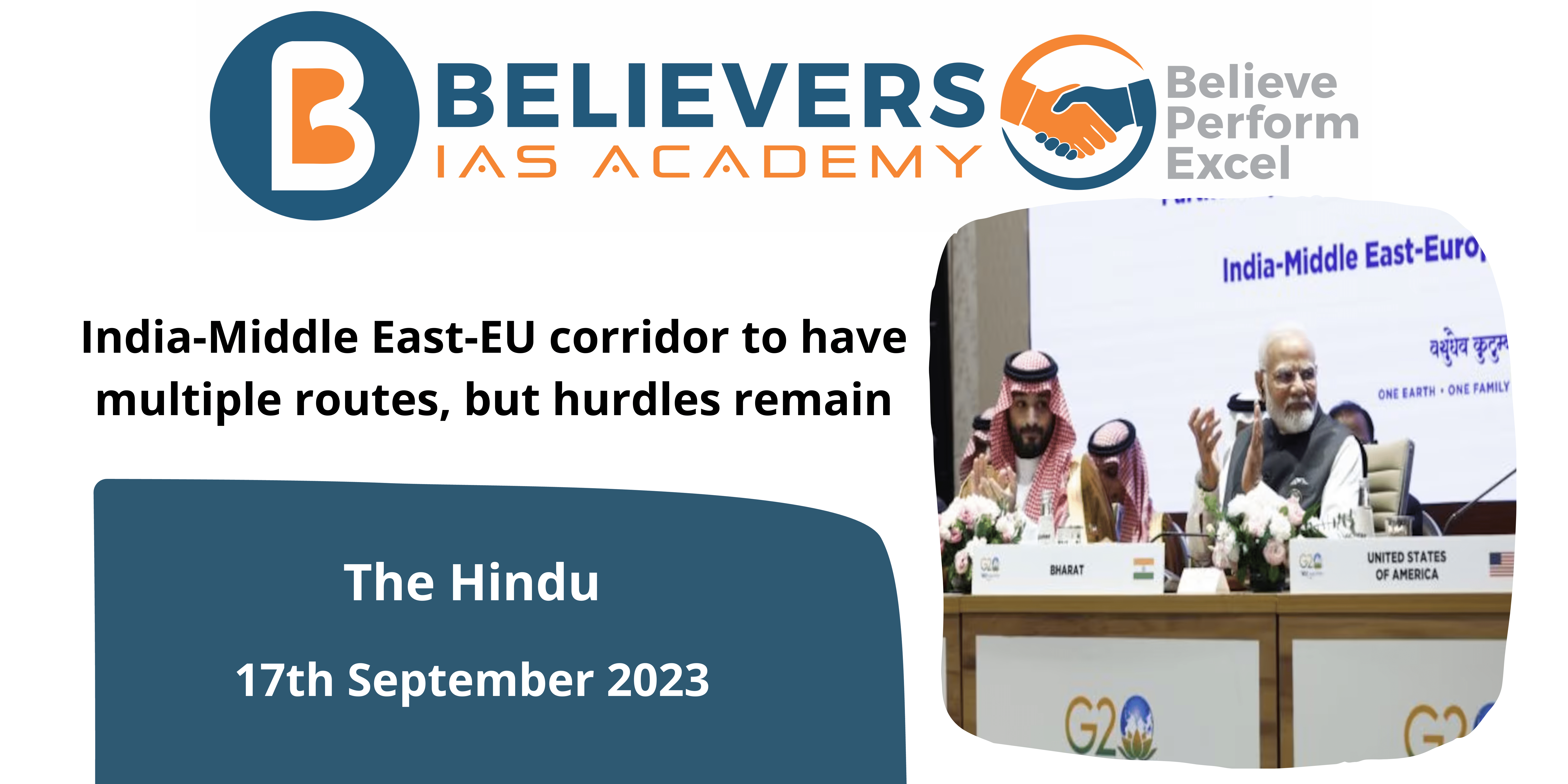India-Middle East-EU corridor to have multiple routes, but hurdles remain
Context
Officials said many details are still being ironed out days after India, the United States, Saudi Arabia, the United Arab Emirates, and other countries launched the India-Middle East-Europe Economic Corridor (IMEC), and multiple route options are being considered.
What is the IMEC?
- The India-Middle East-Europe Economic Corridor (IMEE-EC) is a rail-based infrastructure development project that aims to connect India, the Middle East, and Europe. The IMEC is a network of transportation corridors that includes railway lines and sea lanes and is supposed to boost economic growth.
- The IMEC is intended to be a network of transportation corridors, including railway lines and sea routes, that will aid economic growth.
Which are the countries participating in the grouping?
- The IMEC is a network of transportation corridors constructed by the governments of India, the United States, Saudi Arabia, the European Union, the United Arab Emirates, France, Germany, and Italy. The Partnership for Global Infrastructure Investment (PGII) includes the IMEC. The IMEC is thought to be a response to China’s Belt and Road Initiative (BRI).
What is the geopolitical Significance of the corridor?
- Counter to Chinese Belt and Road Initiative (BRI): IMEC is considered as an alternative to China’s Belt and Road Initiative (BRI), which has been criticized for creating debt traps and boosting China’s influence in participating countries. IMEC offers an alternative infrastructure initiative that is transparent and respectful of member nations’ sovereignty.
- Alliance Strengthening: The organization improves collaboration and deepens alliances among participating countries, particularly between India, the United States, and European states. It promotes a united front in the face of China’s growing influence in Asia and the Middle East.
- Promoting Middle Eastern Stability: By incorporating Middle Eastern countries into the project, IMEC hopes to enhance economic stability in a region that has frequently encountered obstacles, conflicts, and disasters. This can help to maintain Middle Eastern peace and stability.
- Normalization of Diplomatic Relations: The IMEC initiative provides a chance for the normalization of diplomatic relations, including potential diplomatic connections with countries such as Israel and Saudi Arabia. This has broader consequences for regional peace and cooperation.
- Reduced Geopolitical Dependence: The project provides an alternate transit route, reducing geopolitical reliance on existing channels like as the Suez Canal and the Red Sea, which can be congested and vulnerable to geopolitical tensions.
- G20 function Expansion: IMEC enhances the G20’s function from a merely economic to a geopolitical one. It enables the G20 to address geopolitical concerns and fight the influence of countries such as China and Russia.
Which are the ports used in this project?
- On the west coast of India, ports like Mundra, Kandla in Gujarat, and Jawaharlal Nehru Port Trust in Navi Mumbai are being considered for connectivity. In the Middle East, ports like Fujairah, Jebel Ali, and Abu Dhabi in the UAE, as well as Dammam and Ras Al Khair ports in Saudi Arabia, are shortlisted for connection to Indian ports.
What is the impact on the trade with the arrival of IMEC?
- Increased Trade Volume:
-
-
- IMEC wants to connect these regions by establishing efficient transportation corridors such as railways and marine lanes. This improved connection has the potential to raise the volume of trade between participating countries and regions.
- IMEC can make commerce more appealing and economically viable by lowering transportation times and costs and encouraging enterprises to expand their trade activity.
-
- Trade channel Diversification:
-
-
- IMEC provides an alternate trade channel that expands possibilities for countries engaged. Currently, most trade between India and Europe takes place through the Suez Canal, which is prone to congestion and geopolitical problems.
- Countries can use IMEC to lessen their reliance on current routes like as the Suez Canal and the Red Sea, possibly lowering the risks associated with disruptions on these routes.
-
- Trade Competitiveness:
-
-
- IMEC is expected to make trade between India and Europe faster and more efficient, which can enhance the competitiveness of goods from these regions in the global market.
- Reduced transportation times can lead to fresher and more time-sensitive goods reaching their destinations, improving market access.
-
- Economic Integration:
-
-
- IMEC promotes economic integration by connecting various countries and regions. This can lead to the development of supply chains that span multiple nations, facilitating the movement of goods and services.
- Integrated economies can benefit from economies of scale and specialization, potentially boosting overall economic growth.
-
- Impact on Existing Trade Routes:
-
- While IMEC provides an alternative route, it may also impact existing trade routes, such as the Suez Canal. Depending on the competitiveness and efficiency of IMEC, some trade may shift from traditional routes to the new corridor.
What are the hurdles faced by the IMEC?
- Geopolitical Complexities: IMEC involves several countries with a wide range of geopolitical interests. Balancing the interests and concerns of all participating countries can be difficult.
- Financing: The growth of IMEC necessitates large sums of money to build railways, ports, digital infrastructure, and other components. Mobilizing finances for such a large-scale undertaking might be difficult.
- Regulatory Harmonization: Harmonization of regulations across participating countries is critical for seamless trade and transportation. It can be difficult to ensure that trains run on the same gauge, container dimensions are regulated, and customs procedures are expedited.
- Political Stability: The corridor’s success is dependent on political stability in the regions through which it traverses. Political unrest or conflicts could stymie operations and investment.
- Chinese Competition: China’s Belt and Road Initiative (BRI) has already made substantial investments in the IMEC zones. Competing with Chinese initiatives and overcoming potential Chinese opposition could be difficult.





